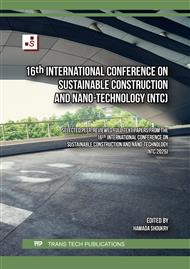[1]
Rabajczyk, A.; Zielecka, M.; Popielarczyk, T.; Sowa, T. Nanotechnology in Fire Protection— Application and Requirements. Materials 2021, 14, 7849
DOI: 10.3390/ma14247849
Google Scholar
[2]
Harmathy, T., Sultan, M., and MacLaurin, J. (1987). "Comparison of Severity of Exposure in ASTM E 119 and ISO 834 Fire Resistance Tests." ASTM International. J. Test. Eval. November 1987; 15(6): 371–375
DOI: 10.1520/JTE11036J
Google Scholar
[3]
ICC NTA, ASTM E119 and Fire Resistance Standards, Available online: https://www.icc-nta.org/astm-e119-and-fire-resistance-standards/
DOI: 10.1520/e2032-21
Google Scholar
[4]
Maluk, C., Bisby, L., and Torero, J. (2017). "The Performance of Intumescent Coatings in Fire Protection Applications." Fire Safety Journal, 91, 104-115.
Google Scholar
[5]
White, R., and Dietenberger, M. (2010). "Fire Performance of Wood Products and Coatings." Forest Products Laboratory Report.
Google Scholar
[6]
Kumar, P., Sharma, R., and Singh, R. (2020). "Advances in Nano-Enhanced Fire Retardant Coatings." Journal of Materials Science, 55(14), 5892-5908.
Google Scholar
[7]
Giorgi, R., Baglioni, M., Berti, D., and Baglioni, P. (2005). "New Nanomaterials for the Conservation of Artworks." Accounts of Chemical Research, 33(8), 798-805.
Google Scholar
[8]
The ICC NTA, ASTM E119 and Fire Resistance Standards, Available online: https://www.icc-nta.org/astm-e119-and-fire-resistance-standards/
DOI: 10.1520/e2032-21
Google Scholar
[9]
Safeopia, Fire Protection. 2018. Available online: https://www.safeopedia.com/definition/ 193/ fire-protection (accessed on 18 april 2024).
Google Scholar
[10]
Rabajczyk, A.; Zielecka, M;. Popielarczyk, T.; Sowa, T. Nanotechnology in Fire Protection-Application and Requirements . Materials 2021, 14, 7849. https//:doi.org/
DOI: 10.3390/ma14247849
Google Scholar
[11]
Costes, L., Laoutid, F., Brohez, S., Dubois, P., 2017. Bio-based flame retardants: When nature meets fire protection. Mater. Sci. Eng.: R: Reports 117, pages no from 1–25
DOI: 10.1016/j.mser.2017.04.001
Google Scholar
[12]
Malucelli, G., Carosio, F., Alongi, J., Fina, A., Frache, A., Camino, G., 2014. Materials engineering for surface-confined flame retardancy. Mater. Sci. Eng. R: Reports 84 (2014), pages no from 1–20.
DOI: 10.1016/j.mser.2014.08.001
Google Scholar
[13]
Dimes, F.G., & Ashurst, J. (1998). Conservation of Building and Decorative Stone (1st ed.). Routledge, pages no from 303–338
DOI: 10.4324/9780080502908
Google Scholar
[14]
Hansen, Eric & Rodriguez-Navarro, Carlos & Van Balen, Koenraad. (2008). Lime putties and mortars: Insights into fundamental properties. Studies in Conservation. page no from 53. 9-23
DOI: 10.1179/sic.2008.53.1.9
Google Scholar
[15]
C, Rodriguez-Navarro, E, Ruiz-Agudo, M, Ortega-Huertas, E, Hansen, Nanostructure and Irreversible Colloidal Behavior of Ca(OH)2: Implications in Cultural Heritage Conservation , page no from 9-23. https://pubs.acs.org/doi/.
DOI: 10.1021/la051338f
Google Scholar
[16]
López-Arce, P., Gomez-Villalba, L.S., Martínez-Ramírez, S., de Buergo, M.Á. and Fort, R., 2011. Influence of relative humidity on the carbonation of calcium hydroxide nanoparticles and the formation of calcium carbonate polymorphs. Powder technology, 205(1), pp.263-269.
DOI: 10.1016/j.powtec.2010.09.026
Google Scholar
[17]
Rodriguez-Navarro, C., Ruiz-Agudo, E., Ortega-Huertas, M. and Hansen, E., 2005. Nanostructure and irreversible colloidal behavior of Ca (OH) 2: implications in cultural heritage conservation. Langmuir, 21(24), page no from.10948-10957.
DOI: 10.1021/la051338f
Google Scholar
[18]
Jinmeng Zhu, Xuanhua Li, Yuanyuan Zhang, Jia Wang, Yijian Cao, Mara Camaiti, and Bingqing We, Dual Functionalities of Few-Layered Boron Nitrides in the Design and Implementation of Ca(OH)2 Nanomaterials toward an Efficient Wall Painting Fireproofing and Consolidation, page no from 5- 22
DOI: 10.1021/acsami.9b00826
Google Scholar
[19]
Victoria E. García-Vera, Antonio José Tenza-Abril, Afonso Miguel Solak, Marcos Lanzón, Calcium hydroxide nanoparticles coatings applied on cultural heritage materials: Their influence on physical characteristics of earthen plasters, page no from 4 - 7.
DOI: 10.1016/j.apsusc.2019.144195
Google Scholar
[20]
Harmathy, T., Sultan, M., and MacLaurin, J. (November 1, 1987). "Comparison of Severity of Exposure in ASTM E 119 and ISO 834 Fire Resistance Tests." ASTM International. J. Test. Eval. November 1987; 15(6): 371–375.page no from 4- 8
DOI: 10.1520/JTE11036J
Google Scholar
[21]
GLC Paints, http://glcpaints.com/ (accessed on 12 February 2024).
Google Scholar
[22]
"Homogenizers for laboratory or industrial homogenization" (accessed on 24 February 2024).
Google Scholar


